December 2016
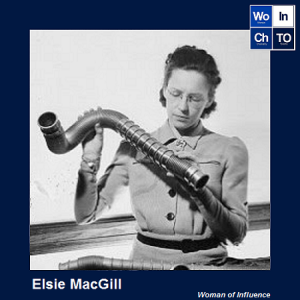
Elsie MacGill (1905 – 1980)
Elsie MacGill was born in 1905 in Vancouver, BC. Both her mother and maternal grandmother were early feminist pioneers in Canada, so it’s no surprise that MacGill herself would become an important figure in Canadian women’s history. MacGill became the first woman to earn a degree in electrical engineering at the University of Toronto (1927), the first to earn a M.A. in aeronautical engineering (1929), and would later become the first woman to be granted professional association with the Engineering Institute of Canada (1938). In 1929, MacGill contracted polio, and was temporarily confined to a wheelchair. While recovering, she spent time designing aircrafts, writing articles about aviation, and participating in various feminist organizations. In 1938 MacGill became chief aeronautical engineer at Canadian Car & Foundry, where she was contracted to build Hawker Hurricane fighter planes during WWII.
In addition to her trailblazing work as an engineer, MacGill was also a staunch feminist whose pro-choice beliefs were incredibly controversial at the time. One of the many important roles she undertook was being one of the five female commissioners with the Royal Commission on the Status of Women (1967-70); she spent the rest of her life pressuring the government to ensure the committee’s recommendations were implemented.
MacGill was certainly ahead of her time, gaining prominence in a field that continues to be male-dominated, proving that she is an important figure to Canadian women broadly, as well as those entering the S.T.E.M. fields. Her significance as a woman of influence is evident from the many awards and honours she received, including the Order of Canada, induction into U of T’s Engineering Hall of Distinction, and, most recently, being short-listed as 1 of 12 iconic Canadian women who could be featured on Canada’s $10 bill.
November 2016
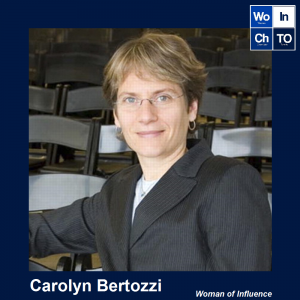
Carolyn Bertozzi (1966 – present)
Carolyn R. Bertozzi is the Anne T. and Robert M. Bass Professor of Chemistry at Stanford University and an Investigator at the Howard Hughes Medical Institute (HHMI). She initially began her undergraduate degree in biology at Harvard University. But after taking the required organic chemistry course in second year, she fell in love with her new field of study, switched to a major in chemistry, and never looked back. Bertozzi went on to do a PhD at UC Berkeley under the supervision of Prof. Mark D. Bednarski, focusing her research on synthesizing carbohydrates that interacted with bacterial and viral receptors. She decided to conduct her postdoctoral work in biology with Prof. Steven D. Rosen at UC San Francisco. After her postdoc, she joined the UC Berkeley faculty and then moved to Stanford University in 2015.
Bertozzi’s research lies at the intersection on chemistry and biology. She has made a multitude of major scientific discoveries in developing and engineering new tools for learning how biological systems function. She is most recognized for founding the field of bioorthagonal chemistry which is the ability to conduct a chemical reaction in a living system without interfering with the native biochemical process. This research is extremely important for learning about how diseases, such as cancer, progress within a cell. Bertozzi has been recognized with many honors and awards for her pioneering research and teaching accomplishments. She is an elected member of the Institute of Medicine, National Academy of Sciences, and American Academy of Arts and Sciences. She has been awarded the Lemelson-MIT Prize, the Heinrich Wieland Prize, and a MacArthur Foundation Fellowship, among many others.
October 2016
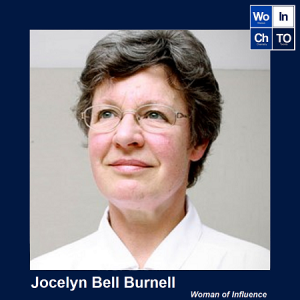
Jocelyn Bell Burnell (1943 – present)
Jocelyn Bell Burnell is an astrophysicist who helped build a large radio telescope and discovered pulsars, providing the first direct evidence for the existence of rapidly spinning neutron stars. She earned her bachelor’s degree in physics at the University of Glasgow in 1965 and her doctorate degree in radio astronomy from University of Cambridge in 1969. One of several research assistants and students working under astronomers Anthony Hewish, her thesis advisor, and Martin Ryle, over the next two years she helped construct a massive radio telescope designed to monitor quasars. By 1967 it was operational and Bell Burnell was tasked with analyzing the data it produced. Her work that led to the discovery of pulsars was published in the February 1968 issue of Nature. Bell Burnell was listed as second author, with Hewish’s name appearing first.
In 1974, only her supervisors Hewish and Ryle received the Nobel Prize in Physics for the work, despite the fact that it was Bell Burnell who had made the discovery. Bell has said that she had to be persistent in reporting the anomaly in the face of scepticism from Hewish, who was initially insistent that it was due to interference and man-made. She spoke of meetings held by Hewish and Ryle to which she was not invited. Many in the scientific community raised their objections, believing that Bell Burnell had been unfairly snubbed. But Bell Burnell humbly rejected the notion, feeling that the prize had been properly awarded given her status as a graduate student, though she has also acknowledged that gender discrimination may have been a contributing factor. After receiving her doctorate from Cambridge, she taught and studied gamma ray astronomy at the University of Southampton. Bell Burnell then spent eight years as a professor at University College London, where she focused on x-ray astronomy.
She has served as dean of science at the University of Bath and president of the Royal Astronomical Society. Bell Burnell has also earned countless awards and honors during her distinguished academic career. She was made a dame in 2007, and she is now visiting professor of Astrophysics at Oxford University, and president of the Royal Society of Edinburgh.
September 2016
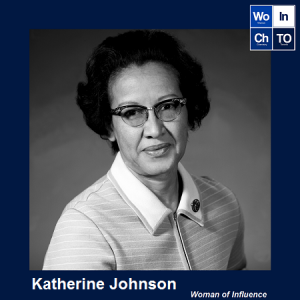
Katherine Johnson (1918 – present)
Katherine Johnson was born in White Sulphur Springs, West Virginia, USA. She is a well-known physicist, space scientist, and mathematician who made fundamental contributions to aeronautics and space programs at NASA through the application of digital and electronic computers.
After graduating high school at the age of 14, Johnson began studies at West Virginia State College, where she graduated summa cum laude in 1937 with degrees in math and French at age 18. In 1938, Johnson was the first African American woman to desegregate the graduate school at West Virginia University.
After obtaining her graduate degree, Johnson decided on a career in research mathematics – a path difficult to pursue for African American women at the time. After some time spent teaching, she was offered a job in 1953 at the National Advisory Committee for Aeronautics, later to become NASA. After being assigned to numerous divisions as a “computor” (individuals who performed precise mathematical calculations for various flight research teams), she was assigned to the Spacecraft Controls Branch as an aerospace technologist. During this time, Johnson made crucial calculations for many important space flights, such as Alan Shepard’s flights into space, the Friendship 7 flight, and the Apollo Moon landing. Later in her career she worked on the Space Shuttle Program, the Earth Resources Satellite, and on plans for a mission to Mars. Her ability and reputation for accuracy in her calculations additionally helped to establish confidence in calculations done by electronic computers. Johnson retired in 1983.
Johnson was assertive in her career and made great efforts to ignore gender and racial barriers, making her at times the only woman to operate within all-male research teams. She co-authored over 25 scientific papers in addition to receiving a multitude of honors, including the highly prestigious Presidential Medal of Freedom in 2015. The Katherine G. Johnson Computational Research Facility was formally dedicated to Johnson in May 2016 at NASA’s Langley Research Centre.
August 2016
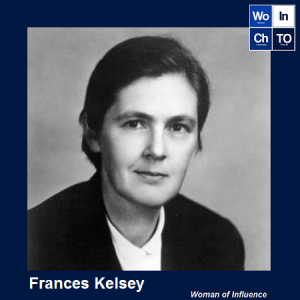
Dr. Frances Kelsey (1914 – 2015)
Dr. Frances Kelsey was a pharmacologist and a physician, hired by the United States Food and Drug Administration (FDA) to review drug applications. In her role at the FDA, she refused to accept an application for thalidomide, a morning sickness drug, to be sold in the US market. Dr. Kelsey had some concerns regarding the drug’s safety. Soon after, thalidomide was discovered to have teratogenic effects, causing infants to be born with severe limb malformations. Approximately 10,000 children were affected by thalidomide, and only about half of these children survived. Thanks to Dr. Kelsey’s refusal to allow thalidomide into the US market, she prevented hundreds or thousands of birth defects in children. For her work, Dr. Kelsey received the President’s Award for Distinguished Federal Civilian Service in 1962 from President John F. Kennedy. She was the second woman to ever win this award. In addition to Dr. Kelsey’s recognition, the case of thalidomide resulted in the passing of stronger FDA laws regarding pharmaceuticals.
Dr. Kelsey was born in 1914 in Cobble Hill, British Columbia. Canadian by birth, she obtained dual citizenship with the United States later in life. She received her B.Sc. and M.Sc. in pharmacology from McGill University, and her Ph.D. in pharmacology from the University of Chicago.
July 2016
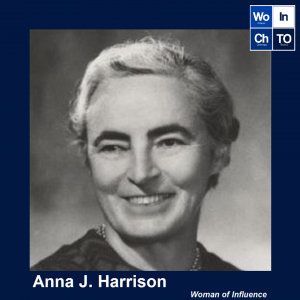
Anna J. Harrison (1912-1998)
Anna J. Harrison was born in Benton City, Missouri in 1912 and completed two BAs, a MA, and a PhD at the University of Missouri in Columbia, Missouri. During World War II, she conducted secret research for the University of Missouri, and contributed to the invention of field smoke detectors for the US Army.
In 1945, Harrison became a professor at Mount Holyoke College in Massachusetts and, having obtained a degree in education, was always an adamant supporter of chemical education, as well as of women in science. Her research at Mount Holyoke College involved spectroscopic studies to elucidate structures of organic compounds, as well as flash photolysis. She worked hand in hand with many US scientific organizations, and served on many advisory boards, including the National Science Board, due to her interest in bringing sound scientific knowledge to voters and policy makers. In 1978, Anna J. Harrison became the first female president of the American Chemical Society.
Harrison died in 1998 in Massachaussets. Her legacy includes her contributions to organic chemistry, her role in policy making, her scientific writing, twenty honorary degrees from various institutions which were awarded to her, and, notably, for her great teaching. She was known to be an extremely compelling science educator – clear, engaged, and witty.
June 2016
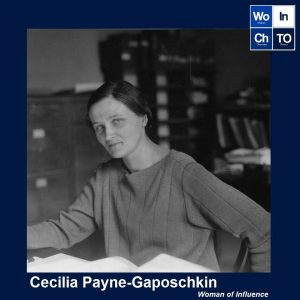
Cecilia Payne-Gaposchkin (1900-1979)
Cecilia Payne-Gaposchkin was a British-American astronomer and astrophysicist. She first became interested in astronomy during her years spent at Cambridge University, which she was attending on scholarship. Although she completed her studies and graduated, she was not awarded a degree because of her gender. It wasn’t until 1948 that Cambridge University began presenting degrees to women.
It was then that Cecilia decided to move to the United States because she realized that she had no future in science in the United Kingdom at the time. In 1923, she began pursuing her graduate studies under Harlow Shapley, who was the Director of the Harvard College Observatory. Shortly after in 1925, she was the first person to earn a Ph.D. in astronomy from Radcliffe College (which is now part of Harvard). Her thesis dissertation – which has been recognized as “the most brilliant Ph.D. thesis ever written in astronomy” – described that the stars are mostly composed of hydrogen and helium. She continued to push the boundaries for women post-graduation by becoming the first woman to be promoted to full professor at the Harvard’s Faculty of Arts and Sciences and then later the first woman to head a department at Harvard.
May 2016
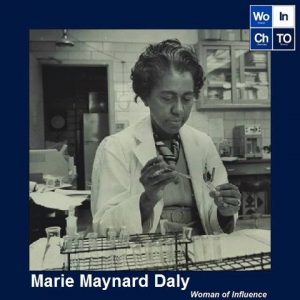
Marie Maynard Daly (1921-2003)
Marie Maynard Daly was the first African-American woman to earn a Ph.D. in chemistry in the United States. Daly was born in 1921 in Queens, New York and was strongly encouraged to pursue higher education throughout her childhood. Daly attended Queens College, where she graduated magma cum laude with her bachelor’s degree in chemistry in 1942. While working as a part-time laboratory assistant at her alma mater, Daly obtained her master’s degree from New York University in 1944, taking just one year to complete.
Shortly after, Daly pursued her doctoral degree at Columbia University under the direction of Dr. Mary L. Caldwell, where she examined how chemicals in the body affected food digestion. As a result of the shortage of male scientists during WWII, Daly was fortunate to obtain funding from the University for her Ph.D. studies. After conducting postdoctoral work at the Rockefeller Institute, Daly returned in Columbia in 1955, working closely with Dr. Quentin B. Deming on the causes of heart attacks. Their most groundbreaking work examined the effect of cholesterol on clogged arteries, revealing how diet can significantly affect heart health and the circulatory system. Daly was relocated to Albert Einstein College in 1960 to continue her research program and was awarded tenure in 1971. Throughout her career, Daly had to overcome the dual hurdles of racial and gender bias, and therefore became a strong advocate for increasing the representation of minorities in the sciences. In 1988, she began a scholarship for African American chemistry and physics majors at Queens College in memory of her father, who never completed his degree in chemistry due to financial constraints.
April 2016

Emmanuelle Charpentier (1968-present) and Jennifer Doudna (1964-present)
Design babies? End world hunger? Eliminate disease? These are just a few of the implications of the technology for which biologists Emmanuelle Charpentier and Jennifer Doudna have gained international recognition since 2012. Together they deciphered the molecular mechanisms of the bacterial CRISPR-Cas9 immune system and repurposed it as a tool for genome editing. Emmanuelle is currently a scientific member and director at the Max Planck Institute for Infection Biology as well as a visiting professor at Umeå University in Sweden. Jennifer is a Professor of Biochemistry and Molecular Biology at the University of California Berkeley. They collaborated to figure out the inner workings of bacterial self-protection and harnessed it to allow scientists to add or remove genetic material at will. Since the discovery of the CRISPR-Cas9 technique, it has been used by geneticists to cut out HIV from the genome, to render wheat invulnerable to killer fungi like mildew and to alter cancer cells to make them more susceptible to chemotherapy. Using CRISPR-Cas9, a scientist could, in theory, make alterations to any human gene. While the implications are just beginning to be imagined, this new technology has sparked a lot of discussion on the ethics of editing the human germline. Emmanuelle and Jennifer have won many awards for their breakthrough including the Dr. Paul Janssen Award for Biomedical Research, Breakthrough Prize in Life Sciences, Princess of Asturias Award, Gruber Prize in Genetics and the Canada Gairdner International Award. As well, Time Magazine designated the duo in the top 100 influential people in the world in 2015.
March 2016
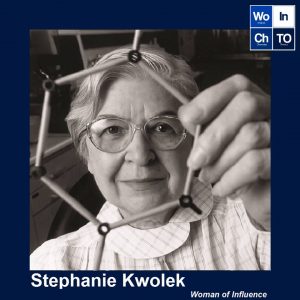
Stephanie Kwolek (1923-2014)
Stephanie Kwolek was an American chemist, most famous for her invention of Kevlar. After completing her B.Sc. in chemistry, Stephanie accepted employment at DuPont with the intention of pursuing medical school thereafter. However, she found the work to be so interesting, that she stayed on for over 40 years. In 1965, Stephanie discovered a class of synthetic fibers, poly-paraphenylene terephthalamides, that exhibited liquid crystal behaviour, and exceptional strength when spun. DuPont commercialized these fibers, better known as Kevlar, and today they are used in more than 200 applications. Kevlar is light, and 5 times stronger than steel due to π-π stacking and hydrogen bonding between adjacent polymer chains. Stephanie’s pioneering work has saved thousands of lives with the incorporation of Kevlar into personal armor, such as ballistic vests and helmets. Her many accolades include 3 honorary degrees, induction into the National Women’s Hall of Fame, the 4th woman inducted into the National Inventor’s Hall of Fame and the National Medal of Technology. In her retirement, Stephanie became heavily involved in promoting scientific fields to young girls through outreach, tutoring and classroom demonstrations such as the Nylon Rope Trick.
February 2016
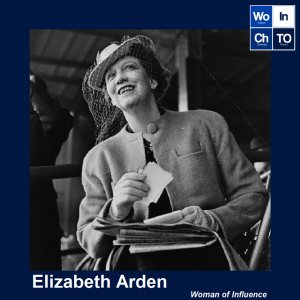
Elizabeth Arden (1878-1966)
Florence Nightingale Graham, better known as Elizabeth Arden, was a Canadian-American business woman who founded the company Elizabeth Arden and established a cosmetic empire in the United States. Born in 1878 in Woodbridge, Ontario, Arden moved to Manhattan later on and spent hours in her brother’s pharmaceutical lab learning about skincare and studying chemistry. Years later, she worked as a beauty culturist and taught women how to apply makeup, and pioneered concepts like the scientific formulation of cosmetics and coordination of colours of makeup.
In addition to being an entrepreneur, Arden was a suffragette. In 1912, she participated with 15,000 women in a march for women’s rights. Suffragettes at the march wore red lipstick as a sign of solidarity—lipstick that was supplied by Arden. She then traveled to France to learn beauty and began expanding her operations in 1915. Her company expanded internationally and changed the face of women’s cosmetics. In 1934, she opened the Maine Chance residential spa in Rome, Maine, the first destination beauty spa in the United States. Arden also became the first woman to grace the cover of TIME magazine in 1946. To recognize her contributions to the cosmetics industry, she was awarded the Légion d’Honneur by the French government in 1962.
January 2016
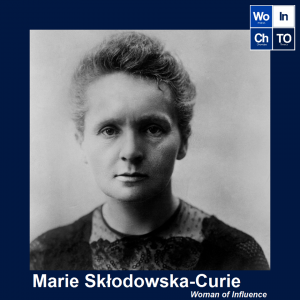
Marie Skłodowska-Curie (1867 – 1934)
Marie Skłodowska-Curie is notably one of the most well-known female scientists. She was a Polish-French physicist and chemist who conducted pioneering research in the field of radioactivity. Her passion for the field lead her to develop the theory of radioactivity, to create novel techniques for isolating radioactive isotopes, and to the discovery of two new elements, polonium and radium. Mme. Curie was awarded the Nobel Prize for Physics in 1903 and for Chemistry in 1911. This made her the first woman to receive a Nobel Prize and the only woman to receive this prestigious award twice. During World War I, she established the first military radiological centers for the treatment of wounded soldiers. Mme. Curie has made multiple significant contributions to the STEM field and will always be known for her scientific breakthroughs.
